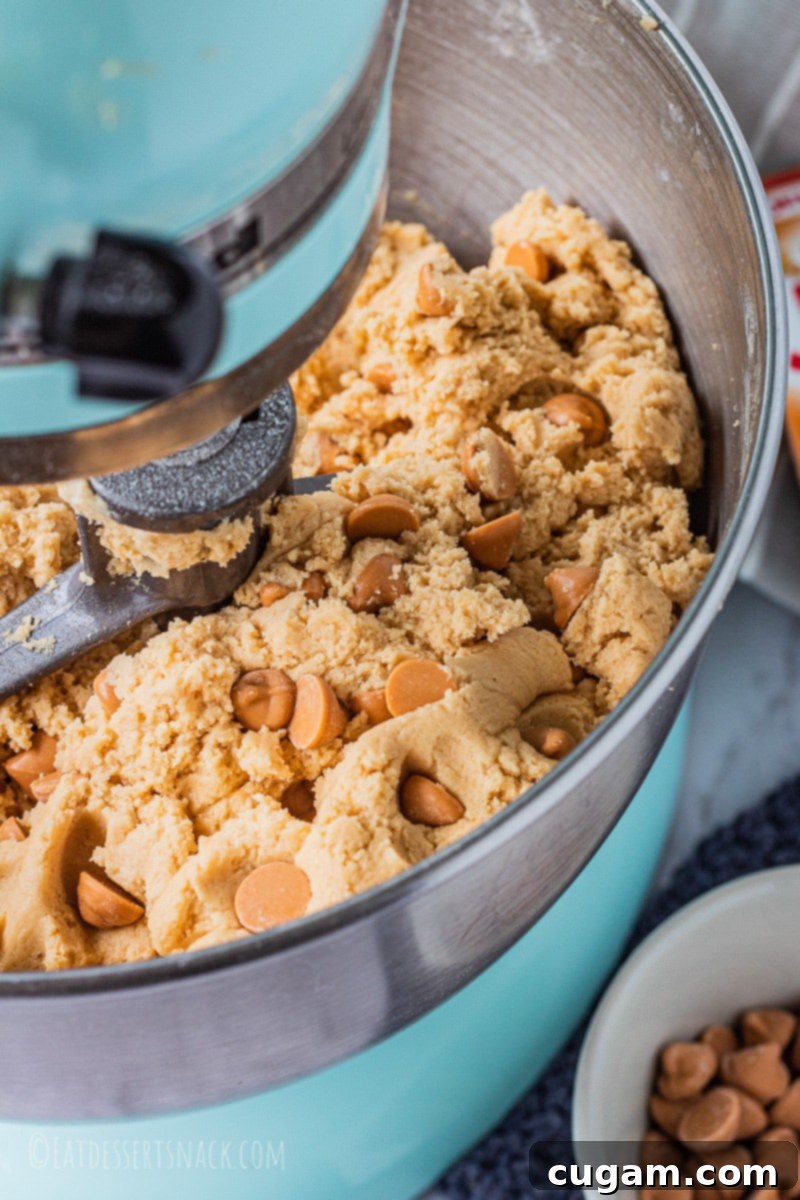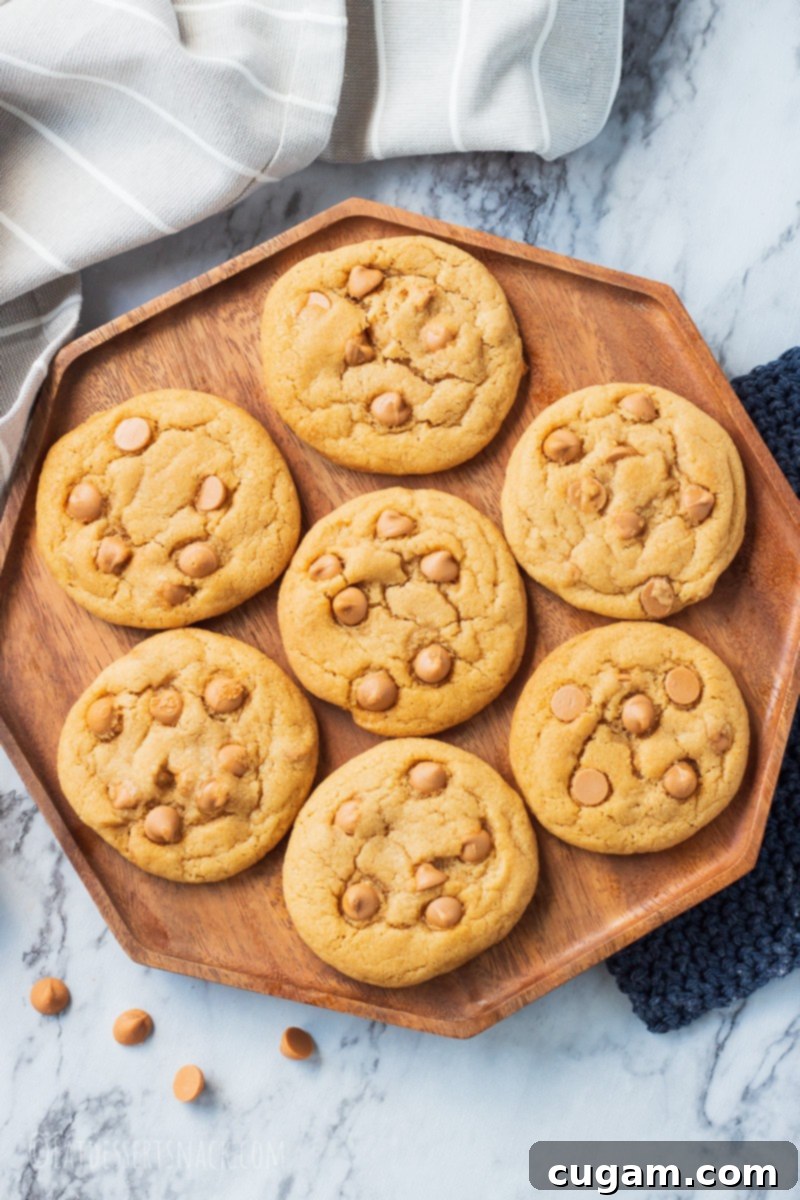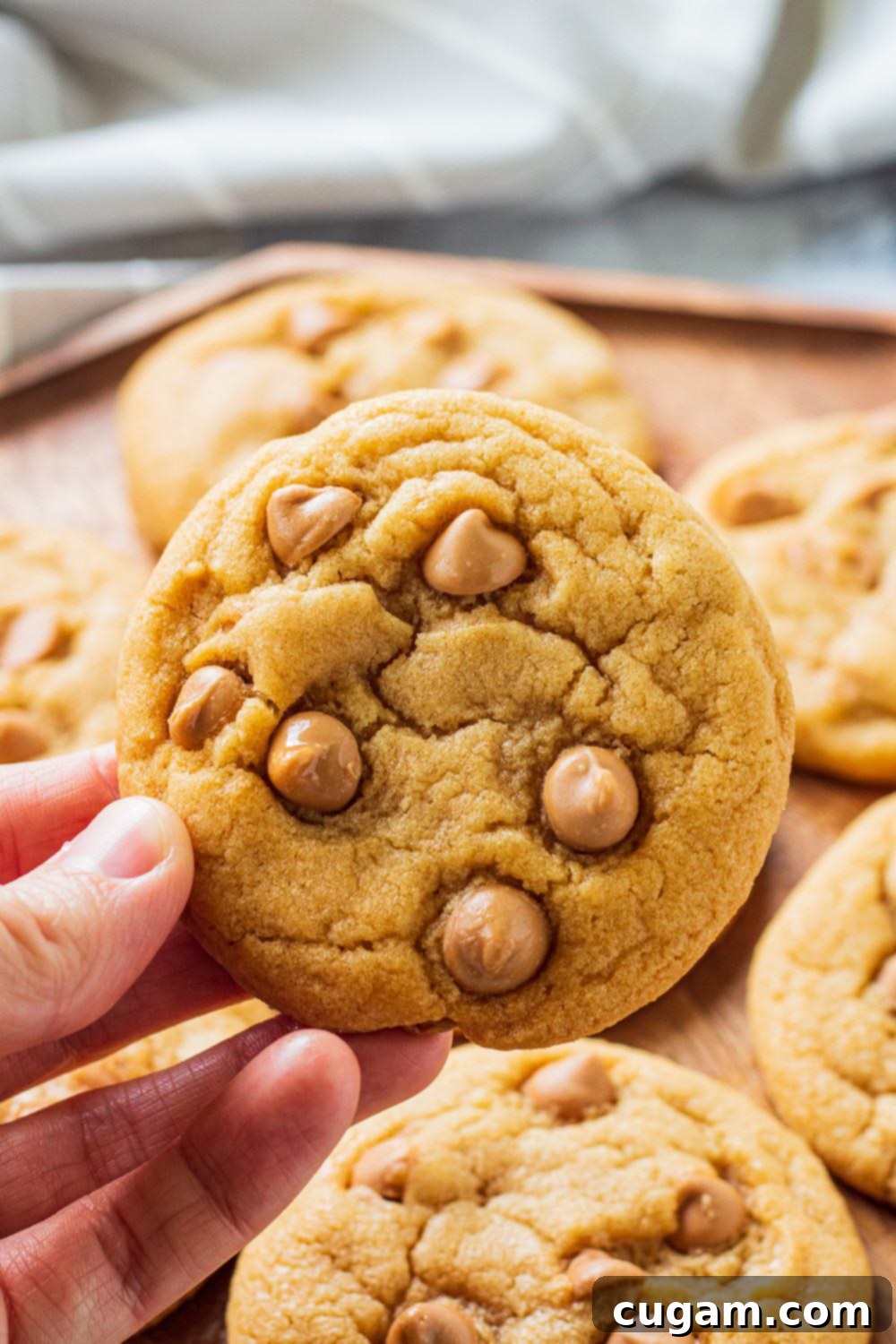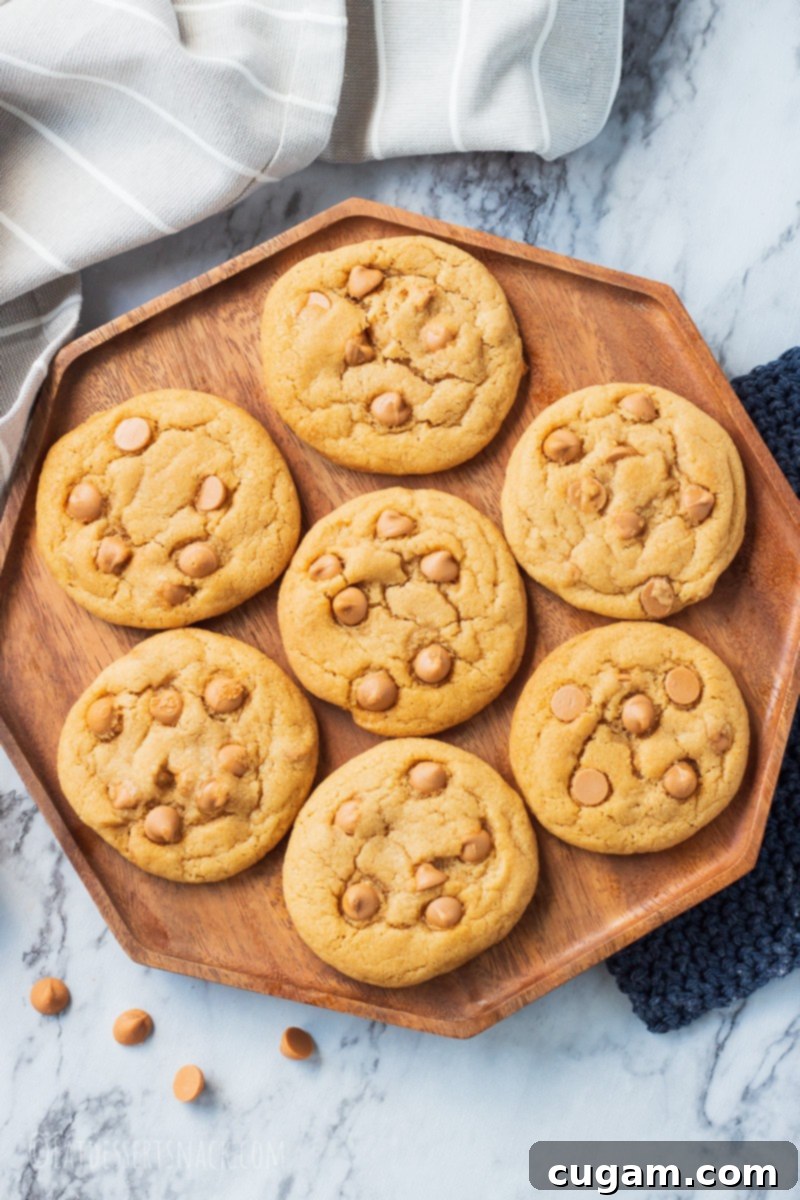Irresistibly Chewy Butterscotch Chip Cookies with Pudding Mix
Prepare to fall in love with these unbelievably **chewy Butterscotch Chip Cookies**, a delightful treat that boasts an incredible depth of caramel flavor. What’s the secret? A magical combination of butterscotch pudding mix and an abundance of butterscotch chips! These ingredients work in harmony to create a cookie that’s soft, rich, and utterly irresistible. If you’re a fan of rich, buttery, and sweet flavors, these cookies are about to become your new obsession.
Cookie recipes featuring pudding mix are truly a game-changer in the baking world. They consistently deliver an unmatched level of moistness and a wonderfully chewy texture that ordinary cookies often lack. Just like my beloved Chocolate Pudding Mix Cookies and the wonderfully unique Pistachio Pudding Mix Cookies, this butterscotch version elevates a classic to a whole new level. Get ready for a baking experience that’s as easy as it is rewarding, yielding results that taste straight out of a professional bakery!

The Ultimate Butterscotch Cookie Recipe: Easy and Delicious
This isn’t just another cookie recipe; it’s an incredibly straightforward method to achieve cookies that will wow everyone. It starts with most of your standard cookie pantry staples: butter, sugar, and eggs. But then, we introduce the two star ingredients that truly make these cookies shine: **instant butterscotch pudding mix** and plenty of **butterscotch chips**. This dynamic duo infuses every bite with a deep, complex caramel flavor that is truly addicting. It’s safe to say, if you love butterscotch, you’re in for a treat. And for those who haven’t yet discovered the magic of butterscotch, you’re truly missing out on a delightful flavor experience!
One of the fantastic aspects of this recipe is the generous yield – it makes a substantial batch of cookies! This means you can easily enjoy some now and save the rest for later. I often bake 12-13 cookies immediately and then freeze the remaining dough in individual balls. This way, I have freshly baked cookies whenever a craving strikes, without all the extra work. Detailed instructions on how to properly freeze the dough for future baking are conveniently included in the recipe notes section below.
How to Make Homemade Butterscotch Chip Cookies from Scratch
Crafting these delectable butterscotch cookies is a simple and enjoyable process. It begins with the crucial step of creaming together the softened butter, white granulated sugar, and light brown sugar. This mixture needs to be beaten until it transforms into a light, fluffy, and pale consistency. This typically takes a good few minutes with a stand or handheld mixer, so don’t rush it! Proper creaming incorporates air, which is essential for the cookies’ texture.
Once the butter and sugars are perfectly creamed, I incorporate the eggs one at a time, followed by the vanilla extract – an essential flavor enhancer. A touch of salt is also added at this stage; trust me, it’s just enough to balance the sweetness without making the cookies salty. Next up are the dry ingredients that contribute to the unique texture: the instant butterscotch pudding mix and baking soda. These are mixed in until just combined.
Finally, I gradually add the all-purpose flour, mixing it on low speed until it’s just incorporated and no streaks of flour remain. Overmixing at this stage can lead to tough cookies, so be gentle! The dough should be soft, pliable, and easily pull away from the sides of the bowl, resembling soft playdough. It definitely shouldn’t be stiff or crumbly. The grand finale is folding in those wonderful butterscotch chips, ensuring they’re evenly distributed throughout the dough for bursts of flavor in every bite.

Expert Tips for Baking the Best Butterscotch Cookies
Achieving bakery-quality butterscotch cookies at home is entirely possible with a few key techniques. These tips don’t just apply to butterscotch cookies; they are fundamental principles for perfecting many cookie recipes:
- Cream the Butter and Sugars Properly: This is a non-negotiable step for optimal cookie texture. Use a stand mixer with the paddle attachment or a handheld mixer and beat the butter, white sugar, and brown sugar together for at least 3 minutes on medium-high speed. The mixture should become noticeably light, fluffy, and pale in color. This process aerates the butter, which is crucial for a soft and tender crumb.
- Always Use Instant Pudding Mix: The butterscotch pudding mix is not just for flavor; it’s a secret weapon for an incredibly moist and chewy cookie. Pudding mix contains cornstarch, which helps tenderize the dough and keeps the cookies soft for longer. While various pudding flavors are available, stick to butterscotch for that authentic, deep caramel taste in this specific recipe.
- Do Not Substitute Butter for Margarine or Shortening: While margarine and shortening might seem like suitable alternatives, they have different fat and water compositions compared to butter. Using them will significantly alter the texture of your cookies, often making them crunchy or brittle instead of the desired soft and chewy. Real butter provides the richness and structure needed for these cookies.
- Save Some Butterscotch Chips for the Tops: For that professional, “fresh out of the oven” bakery look, reserve about ¼ to ½ cup of butterscotch chips to gently press into the tops of the cookie dough balls just before baking. This ensures that beautiful, melty chips are visible on the surface, making them even more appealing.
- Ensure Ingredients are at Room Temperature: Softened butter and room temperature eggs are vital for a smooth, emulsified dough. Cold ingredients won’t cream properly, leading to a less uniform texture in your final cookies.
- Avoid Overmixing the Flour: Once you add the flour, mix on the lowest speed possible until just combined. Overmixing develops the gluten in the flour, resulting in tough, dry cookies instead of soft and chewy ones.

What is the Secret to Making Perfectly Chewy Cookies?
Achieving that coveted chewy texture in cookies is a science, and a few critical factors play a significant role in making these butterscotch chip cookies wonderfully soft and bendy, rather than crisp or cake-like. Let’s delve into the secrets:
- The Egg and Butter to Flour Ratio: A generous amount of fat (butter) and eggs in relation to the flour is crucial. Butter contributes to tenderness and flavor, while eggs, particularly the yolks, add richness and bind moisture, preventing the cookies from drying out. This balance helps create a soft, dense, and chewy crumb structure, rather than a light, airy, or cake-like texture.
- Proper Creaming of Butter and Sugars: As mentioned, creaming the butter and sugars on high speed for at least 3 minutes until light and fluffy is essential. This step doesn’t just incorporate air; it also helps the sugar crystals begin to dissolve into the fat. When sugar dissolves, it inhibits gluten formation and creates a more tender, chewy texture, as opposed to a crispy one.
- The Power of Baking Soda: Baking soda is a vital leavening agent in this recipe. When combined with an acidic ingredient (like brown sugar or even residual acid in butter), it produces carbon dioxide bubbles that help the cookies spread and rise slightly. Without enough baking soda, your cookies won’t spread properly, resulting in dense, little baked balls of dough instead of the lovely, flat, and chewy discs we’re aiming for. It helps create the right structure for chewiness.
- Don’t Overbake! This is perhaps the most critical rule for chewy cookies. Many a potentially perfect cookie has been ruined by staying in the oven for just a few minutes too long. These butterscotch cookies are meant to be soft and chewy, not crunchy. Remove them from the oven when the edges are just barely golden brown and the centers still look slightly underbaked and puffy. They will continue to cook and set as they cool on the hot baking sheet.
- Using Brown Sugar: Brown sugar contains molasses, which adds not only a delicious caramel note but also additional moisture to the dough. This extra moisture is key to keeping the cookies soft and chewy over time.
What Can I Substitute for Butterscotch Chips?
While butterscotch chips are central to the distinct flavor of these cookies, I understand that not everyone is a fan, or perhaps you’re simply looking for a variation. If butterscotch isn’t your preferred flavor, you have options! My Classic Chocolate Chip Pudding Cookies, for example, use vanilla pudding mix and traditional chocolate chips, offering a different but equally delicious experience.
For this specific recipe, if you wish to swap out the butterscotch chips, you could certainly use another type of chocolate chip – milk chocolate, semi-sweet, or even white chocolate chips would work. However, keep in mind that the butterscotch pudding mix will still provide a prominent butterscotch flavor base. If you completely change both the pudding mix and the chips, you’ll essentially create a different cookie altogether!
Other delicious additions could include toffee bits for extra crunch and caramel flavor, or even a mix of white chocolate chips and pecans for a nutty twist. Feel free to experiment with what you have on hand, but remember, the butterscotch pudding mix is the heart of *this* particular recipe’s unique taste.

How to Freeze Butterscotch Chip Cookies and Dough:
These butterscotch chip cookies are perfect for making ahead and freezing, whether as baked cookies or raw dough. Freezing cookie dough is a fantastic time-saver, allowing you to have warm, fresh cookies with minimal effort whenever you desire. Here’s how to do it effectively:
- Prepare the Dough: Make the cookie dough recipe as directed in the instructions below.
- Scoop and Freeze Individually: Using a cookie scoop (1-½ inch is ideal), portion out the dough into uniform balls. Place these dough balls onto a baking sheet lined with parchment paper or a silicone baking mat. Ensure the dough balls are close together but not touching, so they don’t freeze into a single mass.
- Transfer to Storage: Freeze the dough balls for at least 4 hours, or preferably overnight, until they are solid. Once frozen solid, transfer the individual dough balls from the baking sheet into a freezer-safe bag or an airtight container. This prevents freezer burn and allows you to easily grab just a few cookies at a time. Store in the freezer for up to 3 months.
- To Bake Thawed Dough: The night before you plan to bake, transfer the desired number of frozen cookie dough balls from the freezer to the refrigerator to thaw overnight. Once thawed, place them onto a prepared cookie sheet (lined with parchment paper). Preheat your oven to 350°F (175°C) and bake as directed in the recipe (typically 10-12 minutes).
- To Bake While Frozen: For an even quicker bake, you can bake the cookie dough balls directly from frozen. Preheat your oven to 350°F (175°C). Place the frozen cookie dough balls onto a prepared baking sheet. Bake for 13-15 minutes, or until the edges are barely golden brown and the tops are just beginning to crack. Since they are frozen, they will take slightly longer than thawed dough. Start checking at 13 minutes and then every minute until they reach your desired doneness.

More Easy Cookie Recipes to Try:
It’s no secret that I have a passion for cookies – from quick and simple creations to those that feel a bit more fancy, there’s always a cookie for every occasion! The beauty of baking is that with a little practice, any cookie becomes easy to master. If you enjoyed these butterscotch delights, you’ll surely love exploring some of my other favorite recipes. I’ve even included a much-loved STUFFED cookie recipe for when you’re feeling extra adventurous!
- Chocolate Pudding Mix Cookies: Rich, fudgy, and incredibly soft, these are a chocolate lover’s dream.
- Pistachio Pudding Mix Cookies: A unique and vibrantly colored cookie with a subtle nutty flavor.
- Strawberry Pop Tart Cookies: A playful and nostalgic cookie that tastes just like your favorite childhood toaster pastry.
📝 Printable Recipe

Butterscotch Chip Cookies
Pin Recipe
Ingredients
- 1½ cups butter (3 sticks)
- 1 cup white granulated sugar
- 1 cup light brown sugar
- 2 large eggs
- 2 teaspoons vanilla extract
- 1½ teaspoons salt
- 2 teaspoons baking soda
- 1 3.5 oz box instant butterscotch pudding mix
- 4¼ cups all purpose flour
- 2 cups butterscotch chips
Instructions
-
Preheat oven to 350 degrees F (175°C). Line a cookie sheet with parchment paper or a silicone baking mat for easy cleanup and to prevent sticking.
-
In a stand mixer fitted with the paddle attachment (or using a handheld mixer), combine the softened butter, white granulated sugar, and light brown sugar. Beat on medium-high speed until the mixture is light, fluffy, and significantly paler in color, which should take approximately 3 minutes. Remember to scrape down the sides of the bowl occasionally to ensure everything is evenly incorporated. After creaming, add in the eggs one at a time, mixing until just combined, then add the vanilla extract and mix until fluffy.
-
Next, add the salt, baking soda, and the instant butterscotch pudding mix to the wet ingredients. Mix well on low speed until all these dry ingredients are thoroughly incorporated.
Finally, gradually add the all-purpose flour, one cup at a time, mixing on the lowest speed until the flour is just combined and no dry streaks remain. Be careful not to overmix, as this can make the cookies tough. The resulting cookie dough should have the texture of soft playdough and should easily pull away from the sides of the bowl. It should be pliable, not stiff or crumbly.
Gently fold in the butterscotch chips using a spatula until they are evenly distributed throughout the dough.
-
Using a 1-½ inch cookie scoop (or about 2 tablespoons), drop uniform balls of cookie dough onto the prepared baking sheets. Arrange them in rows of 3 and 2, which allows for baking 13 cookies at a time on a standard sheet, maximizing your oven space.
-
Bake the cookies for 10 to 12 minutes. It is crucial **not to overbake** them if you want them to remain chewy. The cookies are done when the bottoms and edges are just barely golden brown, and the tops are just beginning to show small cracks and still look slightly soft in the center. Baking time may vary depending on your oven and whether you are baking one or two pans simultaneously. If baking two pans, I highly recommend rotating them halfway through the baking time for even cooking.
-
Once baked, let the cookies cool on the baking sheet for 5-10 minutes. This allows them to finish setting up and prevents them from breaking when transferred. After this initial cooling, carefully transfer them to a wire cooling rack to cool completely. The bottoms should be a nice golden brown, while the tops will be just barely golden. Enjoy these wonderfully chewy and flavorful butterscotch chip cookies!
Notes
How to Freeze and Bake Butterscotch Chip Cookie Dough:
Freezing cookie dough is a great way to ensure you always have fresh, homemade cookies on hand. Follow these steps for perfect results:
- Prepare the Dough: Make the cookie dough recipe exactly as directed in the main instructions.
- Scoop Onto Sheet: Using your cookie scoop, portion the dough onto a cookie sheet that has been lined with parchment paper or a silicone baking mat. Place the dough balls close together, but ensure their edges are not touching to prevent them from freezing together.
- Freeze and Store: Freeze the dough balls on the cookie sheet for a minimum of 4 hours, or ideally overnight, until they are completely solid. Once frozen firm, transfer the dough balls into a freezer-safe zip-top bag or an airtight container. This helps prevent freezer burn and keeps the dough fresh for up to 3 months.
- To Bake Thawed Dough: When you’re ready to bake, transfer the desired number of frozen cookie dough balls to the refrigerator overnight to thaw. The next day, place the thawed dough balls onto a prepared cookie sheet. Preheat your oven to 350°F (175°C) and bake the cookies as directed in the recipe, typically for 10-12 minutes.
- To Bake While Frozen: For immediate baking, preheat your oven to 350°F (175°C). Place the frozen cookie dough balls directly onto a prepared cookie sheet. Bake them for 14-16 minutes, or until the edges are just barely golden brown and the tops are showing the first signs of cracking. Because they are frozen, they will require a slightly longer baking time. Start checking for doneness at the 14-minute mark, and then continue checking every minute until they are perfectly baked to your liking.
Nutrition
PIN THIS IMAGE TO SAVE THE RECIPE:

